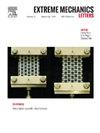A method for identifying the damage thresholds of porcine brain under low- and medium-strain rates
IF 4.5
3区 工程技术
Q2 MATERIALS SCIENCE, MULTIDISCIPLINARY
引用次数: 0
Abstract
Predicting the damage thresholds of brain tissue is crucial for preventing permanent pathological changes and developing therapeutic interventions. This study presents a method for determining the damage thresholds of porcine brain tissue using experimental data and theoretical modeling. By conducting loading and unloading experiments on porcine brain samples, the mechanical responses under varying strain rates and maximum compressive strains are analyzed. A constitutive model incorporating viscoelastic behavior, the Mullins effect, and residual deformation is proposed, effectively characterizing the mechanical properties of the brain tissue. By calculating the ratio of damage-induced dissipated energy and viscoelastic dissipated energy, the extent of damage under different maximum compression strain is quantified. The method’s reliability is validated through examining changes in modulus between the stress–strain curves obtained from the first and second loadings. At a strain rate of 0.3, the mild damage strain threshold is estimated to be 0.2 – 0.3, while the moderate-to-severe damage threshold falls within 0.3 – 0.4, aligning closely with values reported in the literature. Additionally, the damage strain thresholds at 200 are consistent with those at 0.3. The corresponding stress threshold at 200ranges from 5.9 to 11.4 kPa for mild damage and from 11.4 to 22.8 kPa for moderate-to-severe damage. The findings of this study are expected to contribute to brain damage prediction.
中低应变率下猪脑损伤阈值的识别方法
预测脑组织损伤阈值对于预防永久性病理改变和制定治疗干预措施至关重要。本研究提出了一种利用实验数据和理论模型确定猪脑组织损伤阈值的方法。通过对猪脑试样进行加载和卸载实验,分析了不同应变速率和最大压缩应变下的力学响应。提出了一种结合粘弹性行为、Mullins效应和残余变形的本构模型,有效地表征了脑组织的力学特性。通过计算损伤耗散能与粘弹性耗散能的比值,量化了不同最大压缩应变下的损伤程度。通过第一次和第二次加载得到的应力-应变曲线的模量变化,验证了该方法的可靠性。在应变速率为0.3s−1时,估计轻度损伤应变阈值为0.2 - 0.3,而中度至重度损伤阈值在0.3 - 0.4之间,与文献报道的值密切一致。200s−1时的损伤应变阈值与0.3s−1时的损伤应变阈值一致。200s−1的应力阈值范围为:轻度损伤为5.9 ~ 11.4 kPa,中度至重度损伤为11.4 ~ 22.8 kPa。这项研究的结果有望有助于预测脑损伤。
本文章由计算机程序翻译,如有差异,请以英文原文为准。
求助全文
约1分钟内获得全文
求助全文
来源期刊

Extreme Mechanics Letters
Engineering-Mechanics of Materials
CiteScore
9.20
自引率
4.30%
发文量
179
审稿时长
45 days
期刊介绍:
Extreme Mechanics Letters (EML) enables rapid communication of research that highlights the role of mechanics in multi-disciplinary areas across materials science, physics, chemistry, biology, medicine and engineering. Emphasis is on the impact, depth and originality of new concepts, methods and observations at the forefront of applied sciences.
 求助内容:
求助内容: 应助结果提醒方式:
应助结果提醒方式:


